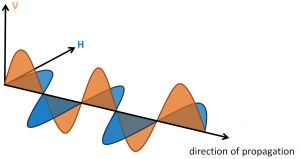I have a strong interest in radar meteorology, particularly in applications of dual-polarization radar data.
 The nationwide network of weather surveillance radars (WSR-88Ds) have been recently upgraded to have dual-polarization capabilities. This means that the radars now simultaneously transmit electromagnetic waves at horizontal and vertical polarizations:
The nationwide network of weather surveillance radars (WSR-88Ds) have been recently upgraded to have dual-polarization capabilities. This means that the radars now simultaneously transmit electromagnetic waves at horizontal and vertical polarizations:

Cartoon illustrating the propagation of orthogonally polarized waves. From Kumjian (2013).
This allows us to obtain information about the sizes, shapes, and composition of particles in the atmosphere. For a review of the principles and applications of polarimetric weather radars, see:
Kumjian, M.R., 2018: Weather radars. Remote Sensing of Clouds and Precipitation, Constantine Andronache, Ed., Springer, 282 pp. Find it here.
Kumjian, M.R., 2013: Principles and applications of dual-polarization weather radar. Part 1: Description of the polarimetric radar variables. Journal of Operational Meteorology, 1(19), 226-242. pdf
Kumjian, M.R., 2013: Principles and applications of dual-polarization weather radar. Part 2: Warm and cold season applications. Journal of Operational Meteorology, 1(20), 243-264. pdf
Kumjian, M.R., 2013: Principles and applications of dual-polarization weather radar. Part 3: Artifacts. Journal of Operational Meteorology, 1(21), 265-274. pdf
